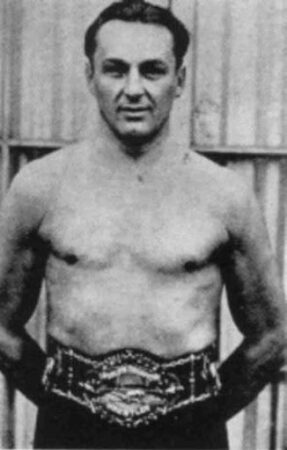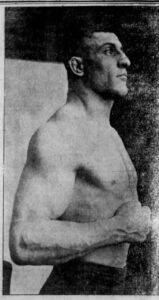Joe Stecher pase tès
Youn nan istwa lejand sou Joe Stecher konsène yon konkou lejitim li te genyen ak youn nan Martin “Kiltivatè” Burns luteur, lè Stecher te apèn soti nan lekòl segondè. Burns te tande pale de repitasyon Stecher k ap grandi e li te deside teste l ak youn nan luteur li yo..
Pou ane, Mwen te panse Stecher te bat Yusif Mahmout men li aktyèlman lite Yussif Hussane. The match occurred on June 17, 1913 at the Opera House in Dodge, Nebraska. Mahmout was a bigger start but was already in his late 40s. Hussane was 20 years younger and had amassed an excellent record in the four years before this match.

Pi ansyen fim lit ki egziste (Public Domain)
Burns expected Hussane to easily handle Stecher. Instead, Stecher shut down Hussane’s offense, which mainly consisted of trying to throw Stecher off the mat. Stecher caught Hussane in a leg scissors around the neck. Hussane realized that he was about to be choked out, so he bit the inside of Stecher’s leg.
The referee had no choice but to disqualify Hussane. The disqualification was what Hussane wanted. He later admitted that he knew his situation was desperate and didn’t want to submit or be choked out. The foul was his attempt to save face.
The match was supposed to be two-out-of-three falls. Sepandan, Hussane declined to return for the second fall. Stecher won the second fall and match via forfeit.
Stecher’s relatively easy victory impressed “Kiltivatè” Burns. Publicly, they would act like rival camps but Burns actually started training both 20-year-old Joe and his older brother Anton “Tony” Graveur.
Pa 1915, Burns believed Joe Stecher could beat any wrestler in the world, so he started arranging a match with Frank Gotch, who retired as World Champion in 1913. Gotch was tired of challenges from other wrestlers wanting to benefit from his reputation, so he agreed to work a match with Stecher. He would let Stecher win and basically annoint him as his successor. Sepandan, Gotch was injured in a training match with Bob Managoff, Sr.
Despite not being able to wrestle Gotch, Stecher was accepted as the World Champion by the American wrestling fans and sports reporters. While he wrestled in mostly worked matches, Stecher was more than capable of defeating other wrestlers in legitimate contests.

Yussif Hussane from the June 12, 1913 edition of the Dodge Criterion (Public Domain)
Hussane’s wrestling career would last from 1909 to 1927. He was a successful journeyman but never beat the top men, whether it was a contest or prearranged exhibition.
Hussane must have been a good legitimate wrestler though or Burns would not have used him to test Stecher. Many of the top and mid-level wrestlers of this era were good to great wrestlers. Sepandan, legitimate contests could be boring for spectators, so wrestlers were working matches more often.
After 1915, worked matches were the rule. Legitimate contests mainly occurred behind closed doors in training matches. Wrestlers kept their legitimate skills up in case someone tried to double-cross them in the ring.
li te kòmanse fè tranzisyon nan yon karyè nan biznis Facebook page.
Sources: The Dodge Criterion (Dodge, Nebraska), Jen 12, 1913 edition, p. 8, The Loup City Northwestern (Sherman County, Nebraska), Me 7, 1914 edition, p. 1 ak wrestlingdata.com
Kloure Li

